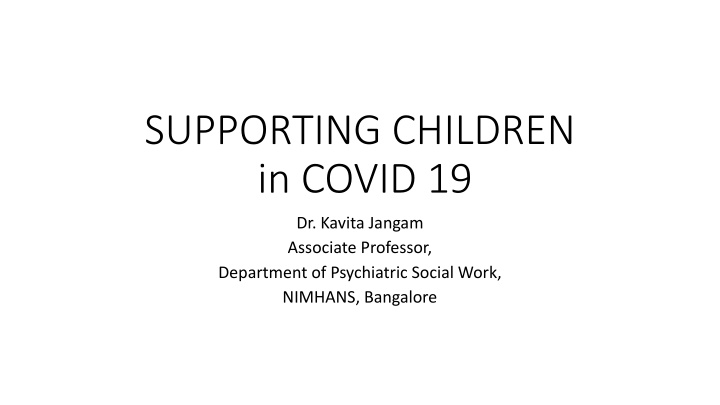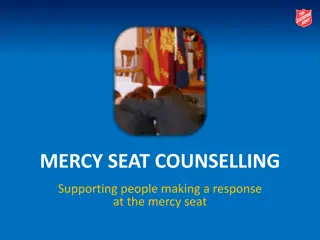
Supporting Children during COVID-19: Challenges and Vulnerabilities
Learn about the unique challenges children face during the COVID-19 pandemic, such as accessing information, emotional unrest, and increased vulnerabilities like abuse and neglect. Discover how social isolation poses risks for children's well-being and their reactions to the pandemic. Find tips on managing boredom, anxiety, and helping children cope effectively.
Download Presentation

Please find below an Image/Link to download the presentation.
The content on the website is provided AS IS for your information and personal use only. It may not be sold, licensed, or shared on other websites without obtaining consent from the author. If you encounter any issues during the download, it is possible that the publisher has removed the file from their server.
You are allowed to download the files provided on this website for personal or commercial use, subject to the condition that they are used lawfully. All files are the property of their respective owners.
The content on the website is provided AS IS for your information and personal use only. It may not be sold, licensed, or shared on other websites without obtaining consent from the author.
E N D
Presentation Transcript
SUPPORTING CHILDREN in COVID 19 Dr. Kavita Jangam Associate Professor, Department of Psychiatric Social Work, NIMHANS, Bangalore
Current situations of COVID 19 might pose unique challenges to caregivers of children in CCIs. Younger children might not have access to or might find it difficult to understand publicly available information on COVID-19. Unaccompanied and separated children may be particularly challenged in accessing timely and relevant information and health services. Children are usually unable to express their fears /anxieties. Prolonged periods of school restrictions may lead to emotional unrest and anxieties. closure and movement
Vulnerabilities for children The situation of lockdown poses significant vulnerabilities for children as there are few means of seeking support. The already existing vulnerabilities are likely to increase many fold. The vulnerabilities can be: Physical Abuse by caregivers Sexual abuse Poor supervision by caregivers Neglect by caregivers Increased risk of violence in CCIs
How social isolation can pose risk for children? Children will not have means of reporting Children will be more neglected as compared to adults and older people Children will be given least preference Poor supervision by caregivers Poor support for children Less no. of people to work with children especially in CCIs
Children reactions to COVID Confused Anxious & worried Angry Reactions of children Depressed Fearful
Boredom Schools have close down early. Moreover unlike other disasters, Covid pandemic has forced everyone to lock themselves inside the house restricting movements for children. Children are likely to feel boredom and depressed without play or contacts with their friends. This boredom and depression affects sleep and appetite and emotional responses of children. Encourage children to develop routine Normalize the routine by adding regular activities such as play hour, TV hour, study hour, activity hour Family members or caretakers need to put in extra efforts to keep children engaged. Encourage more play and physical activities at home.
Anxiety will I get that disease .. Will I die? Many children are likely to have anxiety over questions like will I die of this disease? and so on While some children express these anxieties to their parents, other children may not express it. It is important that the parents / caregivers talk to children about what is going in their mind. Help children express their fears and anxieties through conversation or games. Ask children what they have understood of current situation. Assure children of your presence.
Emotional issues Due to boredom and anxieties, children are likely to be more emotional. They might become more sensitive and have frequent emotional outbursts. Parents and caregivers might find it difficult to comprehend about children moods. Adults must understand that children especially young children do not have capacity to express their feelings and thoughts well. Address the outbursts patiently. Assure children about your presence. When children are calm, talk to them about their outbursts and teach them better ways of managing.
Aggression Along with emotional issues, children are likely to exhibit anger as their regular routine has been disrupted. Especially children with Attention deficit hyperactivity disorders, IDD, autism and other developmental issues likely to feel the loss of daily routine and left with fewer activities This may lead to aggression among children. The caregivers should understand that children with special needs are more sensitive to changes occurring in their environment. Children with special needs have poor communication skills to express their anxiety and fears. Children might become aggressive if their needs (expressive) are not attended by the caregivers. Caregivers may have to provide extra attention to the needs of children special needs. Provide more activities at home and keep them engaged. Normalize the routine as much as possible.
Children with disabilities: We all know children with disability have several vulnerabilities. The presence of disability adds to the already existing vulnerabilities. In current situations, the caregivers must attend to the children with disability and younger children first and then the other children. Maintaining daily self care and hygiene is important for these children as immobility leads to poor self care and increased risk of physical health problems. It is important to keep them engaged as well.
Recommendations/What can be done Recommendations/What can be done Children usually feel relieved if they are able to express and communicate their disturbing feelings in a safe and supportive environment. Creative activity, such as playing and drawing can facilitate this process. Help children find positive ways to express disturbing feelings such as anger, fear and sadness. Encourage an increased sensitive and caring environment around the child. Remember that children often take their emotional cues from the important adults in their lives, so how adults respond to the crisis is very important. If possible, make opportunities for children to play and relax.
Avoid separating children and their caregivers as much as possible. If a child needs to be separated from his/her primary caregiver, ensure that appropriate alternative care is provided If children are separated from their caregivers, ensure regular and frequent contact (e.g. via phone, video calls) and re-assurance. Ensure all child protection and safeguarding measures are addressed. Keep regular routines and schedules as much as possible or help create new ones in a new environment, including learning, playing and relaxing. Give clear child-friendly information about how to reduce risk of infection and stay safe in words they can understand. Demonstrate to children how they can keep themselves safe (e.g., show them effective handwashing)
Avoid speculating about rumours or unverified information in front of children. Provide information about what has happened or could happen in a reassuring, honest and age-appropriate way. Support adults/caregivers with activities for children during home isolation/ quarantine. For example: hand washing games with rhymes imaginary stories about the virus exploring the body make cleaning and disinfecting the house into a fun game draw pictures of virus/microbes that to be coloured by children explain person protective equipment (PPE) to children so that they are not scared
Summary Summary Promote Connectedness Promote Safety Promote Calm Promote Self- Efficacy Promote Help Dr LNSuman Dept of Clinical Psychology NIMHANS 14






















